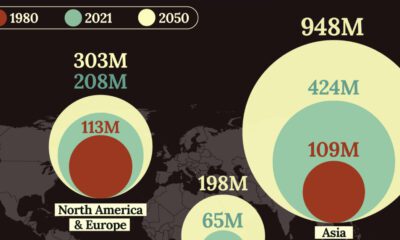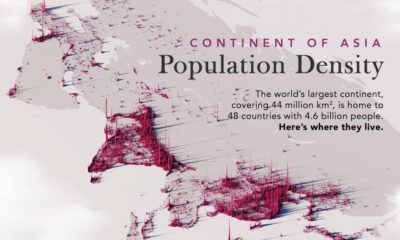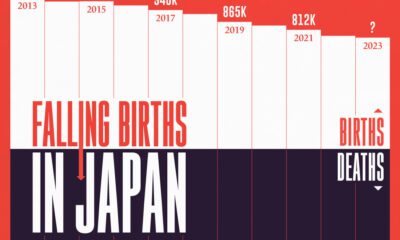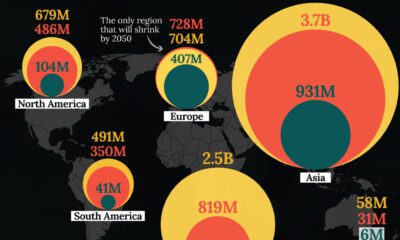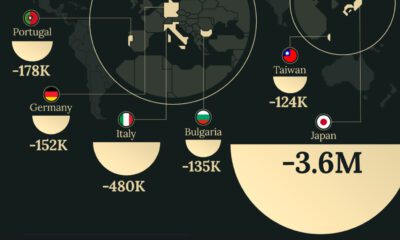Markets
This Map Shows the Most Extreme Comparison of Population Density We’ve Seen
You may have heard that the majority of the world’s population actually lives within a relatively small circle that covers China, India, Japan, and other parts of Southeast Asia.
That’s a pretty extreme example of population density – but here’s one that is even more impressive.
It’s quite simple actually: it compares parts of the most expansive regions (Canada, Russia, non-coastal USA, Greenland, Australia, and others) with a tiny chunk of land that holds close to 400 million people.
An Extreme Comparison of Population Density
The following image comes to us from Metrocosm, the website of data visualization expert Max Galka.
Bangladesh and three provinces in India, which are highlighted in red, take up just 160,000 sq. mi (415,000 sq. km) – that’s smaller than California. Together they hold more population than all of the blue territories on the map.

That’s right, the blue area contains the entirety of many significant countries, such as Canada, Australia, Norway, Sweden, and Saudi Arabia. The blue even includes parts of China, the United States, and most of Russia.
Getting More Extreme
Here’s the kicker – the disparity is only getting more intense. Take a look at the following map of the fastest growing cities, showing the rate of new citizens per hour:
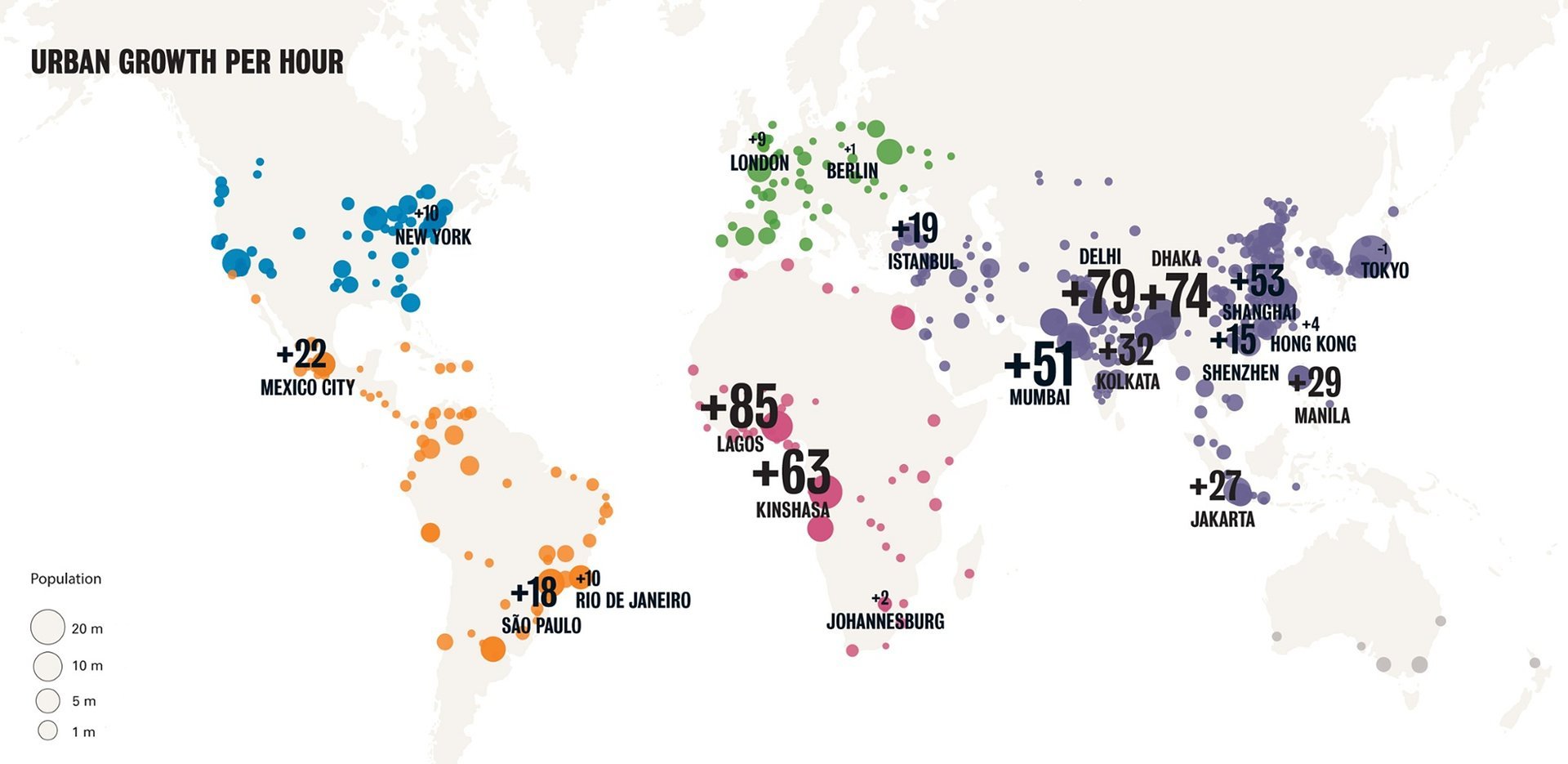
Dhaka, the largest city in Bangladesh, is one of the fastest growing cities in the world with a growth rate of 74 people per hour. Kolkata (India) is also up there, adding 32 citizens every hour.
Meanwhile, the cities within the blue area of the original map do not have the same kind of growth happening at all.
For the Numbers Geeks
Here are the original calculations, from Metrocosm, for the blue and red areas of the original map in case you are interested. It’s worth noting that the data was retrieved in 2015, so it is slightly out of date.
The “Blue” Regions
| Jurisdiction | Region | Population |
|---|---|---|
| Canada | All | 35,010,000 |
| Saudi Arabia | All | 28,123,000 |
| Australia | All | 22,280,000 |
| Russia | Siberian Federal District | 19,254,300 |
| Niger | All | 18,124,000 |
| Kazakhstan | All | 16,137,000 |
| Mali | All | 14,478,000 |
| Zambia | All | 14,440,000 |
| Russia | Northwestern Federal District | 13,583,800 |
| Chad | All | 12,620,000 |
| Russia | Ural Federal District | 12,082,700 |
| Bolivia | All | 10,610,000 |
| Somalia | All | 10,295,000 |
| Sweden | All | 9,437,000 |
| Brazil | Pará | 8,073,924 |
| Papua New Guinea | All | 7,440,000 |
| Paraguay | All | 6,844,000 |
| Russia | Far Eastern Federal District | 6,291,900 |
| Libyan Arab Jamahiriya | All | 5,918,217 |
| China | Qinghai | 5,626,722 |
| Turkmenistan | All | 5,411,000 |
| Finland | All | 5,408,000 |
| Norway | All | 4,985,000 |
| Ireland | All | 4,804,000 |
| New Zealand | All | 4,436,000 |
| Central African Republic | All | 4,191,429 |
| Brazil | Amazonas | 3,873,743 |
| Mauritania | All | 3,623,000 |
| Republic of the Congo | All | 3,609,851 |
| Uruguay | All | 3,412,000 |
| Brazil | Mato Grosso | 3,224,357 |
| Lithuania | All | 3,173,000 |
| Oman | All | 3,110,000 |
| China | Tibet | 3,002,166 |
| United States | Utah | 2,942,902 |
| United States | Kansas | 2,904,021 |
| Mongolia | All | 2,809,000 |
| Brazil | Mato Grosso do Sul | 2,619,657 |
| Namibia | All | 2,352,000 |
| Latvia | All | 2,210,000 |
| Botswana | All | 2,068,000 |
| United States | Nebraska | 1,881,503 |
| Brazil | Rondônia | 1,748,531 |
| Argentina | Mendoza | 1,741,610 |
| United States | Idaho | 1,634,464 |
| Gabon | All | 1,597,000 |
| Brazil | Tocantins | 1,496,880 |
| Estonia | All | 1,338,000 |
| Argentina | Salta | 1,215,207 |
| Argentina | Chaco | 1,053,466 |
| United States | Montana | 1,023,579 |
| Argentina | Corrientes | 993,338 |
| Cyprus | All | 911,000 |
| Argentina | Santiago del Estero | 896,461 |
| United States | South Dakota | 853,175 |
| Fiji | All | 828,046 |
| Brazil | Acre | 790,101 |
| Guyana | All | 757,000 |
| Brazil | Amapá | 750,912 |
| United States | North Dakota | 739,482 |
| United States | Alaska | 736,732 |
| Argentina | San Juan | 680,427 |
| Argentina | Jujuy | 672,260 |
| Argentina | Río Negro | 633,374 |
| Greece | Crete | 620,000 |
| United States | Wyoming | 584,153 |
| Argentina | Neuquén | 550,334 |
| Suriname | All | 540,000 |
| Argentina | Formosa | 527,895 |
| Western Sahara | All | 507,160 |
| Argentina | Chubut | 506,668 |
| Brazil | Roraima | 496,936 |
| Solomon Islands | All | 472,419 |
| Argentina | San Luis | 431,588 |
| Argentina | Catamarca | 367,820 |
| Bahamas | All | 360,000 |
| Iceland | All | 347,000 |
| Belize | All | 335,000 |
| Argentina | La Rioja | 331,847 |
| France | Corsica | 322,000 |
| Argentina | La Pampa | 316,940 |
| Argentina | Santa Cruz | 272,524 |
| Vanuatu | All | 267,000 |
| New Caledonia | All | 266,000 |
| French Guiana | All | 250,377 |
| Guam | All | 165,124 |
| Chile | Magallanes y la Antártica Chilena | 159,152 |
| Argentina | Tierra del Fuego, Antártida e Islas del Atlántico Sur | 126,190 |
| Micronesia | All | 103,549 |
| Kiribati | All | 102,351 |
| Chile | Aysén del General Carlos Ibáñez del Campo | 98,413 |
| Greenland | All | 57,475 |
| Northern Mariana Islands | All | 53,855 |
| Galapagos | All | 25,000 |
| Palau | All | 20,918 |
| Falkland Islands (Malvinas) | All | 3,000 |
| Svalbard | All | 2,642 |
| Norfolk Island | All | 2,169 |
| French Southern and Antarctic Lands | All | 0 |
| South Georgia South Sandwich Islands | All | 0 |
The “Red” Regions
| Jurisdiction | Region | Population |
|---|---|---|
| Bangladesh | All | 172,019,000 |
| India | Bihar | 99,000,000 |
| India | West Bengal | 90,320,000 |
| India | Jharkhand | 32,000,000 |
Markets
The European Stock Market: Attractive Valuations Offer Opportunities
On average, the European stock market has valuations that are nearly 50% lower than U.S. valuations. But how can you access the market?

European Stock Market: Attractive Valuations Offer Opportunities
Europe is known for some established brands, from L’Oréal to Louis Vuitton. However, the European stock market offers additional opportunities that may be lesser known.
The above infographic, sponsored by STOXX, outlines why investors may want to consider European stocks.
Attractive Valuations
Compared to most North American and Asian markets, European stocks offer lower or comparable valuations.
| Index | Price-to-Earnings Ratio | Price-to-Book Ratio |
|---|---|---|
| EURO STOXX 50 | 14.9 | 2.2 |
| STOXX Europe 600 | 14.4 | 2 |
| U.S. | 25.9 | 4.7 |
| Canada | 16.1 | 1.8 |
| Japan | 15.4 | 1.6 |
| Asia Pacific ex. China | 17.1 | 1.8 |
Data as of February 29, 2024. See graphic for full index names. Ratios based on trailing 12 month financials. The price to earnings ratio excludes companies with negative earnings.
On average, European valuations are nearly 50% lower than U.S. valuations, potentially offering an affordable entry point for investors.
Research also shows that lower price ratios have historically led to higher long-term returns.
Market Movements Not Closely Connected
Over the last decade, the European stock market had low-to-moderate correlation with North American and Asian equities.
The below chart shows correlations from February 2014 to February 2024. A value closer to zero indicates low correlation, while a value of one would indicate that two regions are moving in perfect unison.
| EURO STOXX 50 | STOXX EUROPE 600 | U.S. | Canada | Japan | Asia Pacific ex. China |
|
|---|---|---|---|---|---|---|
| EURO STOXX 50 | 1.00 | 0.97 | 0.55 | 0.67 | 0.24 | 0.43 |
| STOXX EUROPE 600 | 1.00 | 0.56 | 0.71 | 0.28 | 0.48 | |
| U.S. | 1.00 | 0.73 | 0.12 | 0.25 | ||
| Canada | 1.00 | 0.22 | 0.40 | |||
| Japan | 1.00 | 0.88 | ||||
| Asia Pacific ex. China | 1.00 |
Data is based on daily USD returns.
European equities had relatively independent market movements from North American and Asian markets. One contributing factor could be the differing sector weights in each market. For instance, technology makes up a quarter of the U.S. market, but health care and industrials dominate the broader European market.
Ultimately, European equities can enhance portfolio diversification and have the potential to mitigate risk for investors.
Tracking the Market
For investors interested in European equities, STOXX offers a variety of flagship indices:
| Index | Description | Market Cap |
|---|---|---|
| STOXX Europe 600 | Pan-regional, broad market | €10.5T |
| STOXX Developed Europe | Pan-regional, broad-market | €9.9T |
| STOXX Europe 600 ESG-X | Pan-regional, broad market, sustainability focus | €9.7T |
| STOXX Europe 50 | Pan-regional, blue-chip | €5.1T |
| EURO STOXX 50 | Eurozone, blue-chip | €3.5T |
Data is as of February 29, 2024. Market cap is free float, which represents the shares that are readily available for public trading on stock exchanges.
The EURO STOXX 50 tracks the Eurozone’s biggest and most traded companies. It also underlies one of the world’s largest ranges of ETFs and mutual funds. As of November 2023, there were €27.3 billion in ETFs and €23.5B in mutual fund assets under management tracking the index.
“For the past 25 years, the EURO STOXX 50 has served as an accurate, reliable and tradable representation of the Eurozone equity market.”
— Axel Lomholt, General Manager at STOXX
Partnering with STOXX to Track the European Stock Market
Are you interested in European equities? STOXX can be a valuable partner:
- Comprehensive, liquid and investable ecosystem
- European heritage, global reach
- Highly sophisticated customization capabilities
- Open architecture approach to using data
- Close partnerships with clients
- Part of ISS STOXX and Deutsche Börse Group
With a full suite of indices, STOXX can help you benchmark against the European stock market.

Learn how STOXX’s European indices offer liquid and effective market access.

-

 Economy1 day ago
Economy1 day agoEconomic Growth Forecasts for G7 and BRICS Countries in 2024
The IMF has released its economic growth forecasts for 2024. How do the G7 and BRICS countries compare?
-

 Markets1 week ago
Markets1 week agoU.S. Debt Interest Payments Reach $1 Trillion
U.S. debt interest payments have surged past the $1 trillion dollar mark, amid high interest rates and an ever-expanding debt burden.
-

 United States1 week ago
United States1 week agoRanked: The Largest U.S. Corporations by Number of Employees
We visualized the top U.S. companies by employees, revealing the massive scale of retailers like Walmart, Target, and Home Depot.
-

 Markets2 weeks ago
Markets2 weeks agoThe Top 10 States by Real GDP Growth in 2023
This graphic shows the states with the highest real GDP growth rate in 2023, largely propelled by the oil and gas boom.
-

 Markets2 weeks ago
Markets2 weeks agoRanked: The World’s Top Flight Routes, by Revenue
In this graphic, we show the highest earning flight routes globally as air travel continued to rebound in 2023.
-

 Markets2 weeks ago
Markets2 weeks agoRanked: The Most Valuable Housing Markets in America
The U.S. residential real estate market is worth a staggering $47.5 trillion. Here are the most valuable housing markets in the country.
-

 Mining1 week ago
Mining1 week agoGold vs. S&P 500: Which Has Grown More Over Five Years?
-

 Markets2 weeks ago
Markets2 weeks agoRanked: The Most Valuable Housing Markets in America
-

 Money2 weeks ago
Money2 weeks agoWhich States Have the Highest Minimum Wage in America?
-

 AI2 weeks ago
AI2 weeks agoRanked: Semiconductor Companies by Industry Revenue Share
-

 Markets2 weeks ago
Markets2 weeks agoRanked: The World’s Top Flight Routes, by Revenue
-

 Demographics2 weeks ago
Demographics2 weeks agoPopulation Projections: The World’s 6 Largest Countries in 2075
-

 Markets2 weeks ago
Markets2 weeks agoThe Top 10 States by Real GDP Growth in 2023
-

 Demographics2 weeks ago
Demographics2 weeks agoThe Smallest Gender Wage Gaps in OECD Countries
